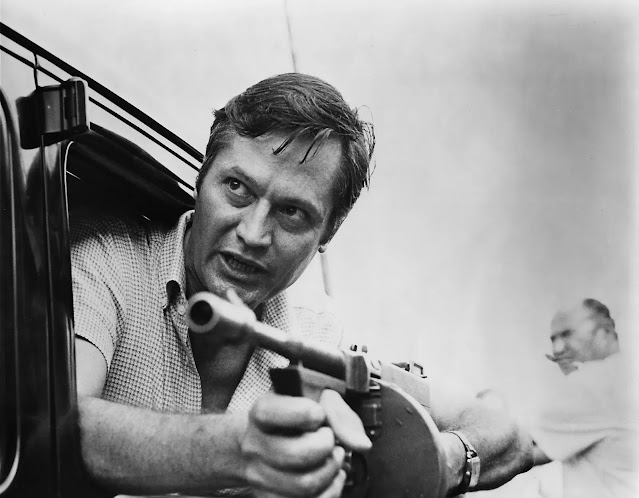28 Days Later (Danny Boyle, 2002)
Although Danny Boyle's post-apocalyptic chiller 28 Days Later (2002) was technically not a zombie film, it undoubtedly spearheaded a revival in zombie cinema. The film would also pave the way for British horror finding its feet again after the wilderness that was the nineties. Thirdly, 28 Days Later would regain Boyle's reputation after his lacklustre film adaptation of Alex Garland's The Beach. Both Boyle and Garland would team-up and deliver what's arguably a modern British classic film, along with laying down the blueprint for zombie cinema in the twenty-first century.
In terms of its premise, Garland's story takes obvious inspiration from John Wyndham's The Day of the Triffids. The protagonist, bike courier Jim (a relatively unknown at the time Cillian Murphy) wakes from a coma in a deserted hospital following a cataclysmic event — a major parallel. Alone and confused, Jim gradually assesses the severity of the situation whilst wondering the desolate streets and landmarks of London. The absense of a population in a vast city make these scenes completely rivetting viewing and have automatically become associated with the film ever since.


Like most post-apocalyptic films, 28 Days Later's protagonist realises he isn't quite alone once he encounters one of the Rage infected. It's a disturbing scene where Jim walks into a church with the words "REPENT THE END IS EXTREMELY FUCKING HIGH" scrawled on a wall, followed by the sight of a mass pile of corpses before an afflicted priest spasdmodically twitches towards the camera. Unlike zombies, the infected are living ghouls driven by rage. Originating from an outbreak of a lab virus during the film's prologue. A scientist warns a group of animal rights activists that the chimps they're freeing also carry mankind's doom. His words aren't heeded.
Jim isn't the only survivor in Blighted Blighty; the battle-hardened Selena (Naomie Harris) hasn't had the fortuity of sleeping through the horrifying outbreak. The machete wielding maiden does not hesitate in hacking to death her companion Mark (Noah Huntley) after he contracts the Rage virus. Selena's character development is like the ying to Jim's yang in terms of their character arcs. Chinks in her stoic armour appear with their potential romance.


With Jim coming to terms with the deaths of his parents and a new reality, he embraces a new family; as
well as the aforementioned Selena, they find Frank (Brendan Gleeson), a
cab driver living in his high rise flat, and his young daughter Hannah
(Megan Burns). The bonds formed with these individuals becomes invaluable for Jim's well being as it's evident in the form of a nightmare
where he fears losing them and feeling alone in the world again. While on guard duty, Frank wakes Jim and assures him not to worry and Jim responds
with the line, "Thanks, Dad!".
Post-apocalyptic films tend to be on the depressing side, and while much of 28 Days Later abundantly offers the same nihilistic feeling, there are a few choice scenes that are a welcome break from its bleak tone. Boyle's homage to the shopping scene from Dawn of the Dead (1978) is a prime example. In another instance, after escaping his execution from a band of military renegades, Jim notices a plane flying high in the sky; suggesting the rest of the world isn't quite as doomed as suggested.


A common element in many a horror or disaster themed film is the secondary antagonist. In this case it consists of a squad of soldiers led by Major Henry West (Christopher Eccleston) introduced in the third act. Potential survivors of the outbreak are lured via a radio message and offered safety from the virus. In reality, the signal exists to gather women for the horny platoon. This callousness is forshadowed by Major West's cold logic bridging the the world of the past with the world of the new with a disturbing summation
"This is what I've seen in the four weeks since infection.
People killing people. Which is much what I saw in the four weeks before
infection, and the four weeks before that, and before that, and as far
back as I care to remember. People killing people. Which to my mind,
puts us in a state of normality right now."


Much of 28 Days Later was filmed with crude digital cameras. Perfect for shooting familiar locations under strict conditions back then. However, the low resolution picture quality is something of an eye sore in our high definition era. It might put off some folk. It's something I became accustomed to after watching the ancient blu-ray I own of the film (in the wrong aspect ratio). Not sure if any later editions were blessed with an improved print, but this visual quality lends to some unexpected noughties charm. The soundtrack on the other hand, has aged remarkably well.
Today, 28 Days Later has left behind a legacy which outshines its meh follow-up 28 Weeks Later (2007); it reinvigorated zombie cinema after George A. Romero had set the template. The film kick started fast zombies. They might have appeared as early as Umberto Lenzi's Nightmare City (1980), but it wasn't until the success of 28 Days Later that everyone else followed suit. It was a game changer. Its influence has not only spread to other acclaimed zombie films since then, such as Yeon Sang-ho's Train to Busan (2016), but its very DNA goes beyond the realm of cinema by extending to television, fashion and politics.
With the news of Boyle, Garland and Murphy returning on 28 Years Later (2025), it will be interesting to see where the film will go and whether it will take inspiration from the spread of the COVID-19 global pandemic, which drew comparisons with the original film at the time.













%20-%20YouTube.png)
%20-%20YouTube.png)
%204K%20AI%20Remaster%20-%20YouTube.png)













